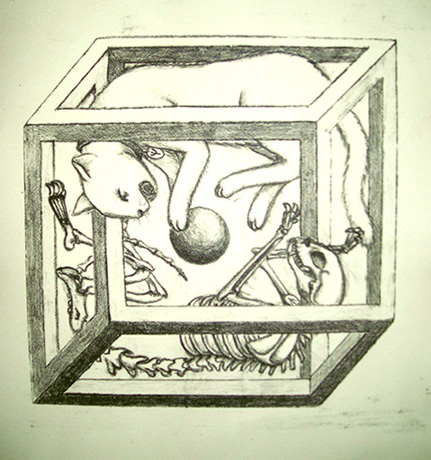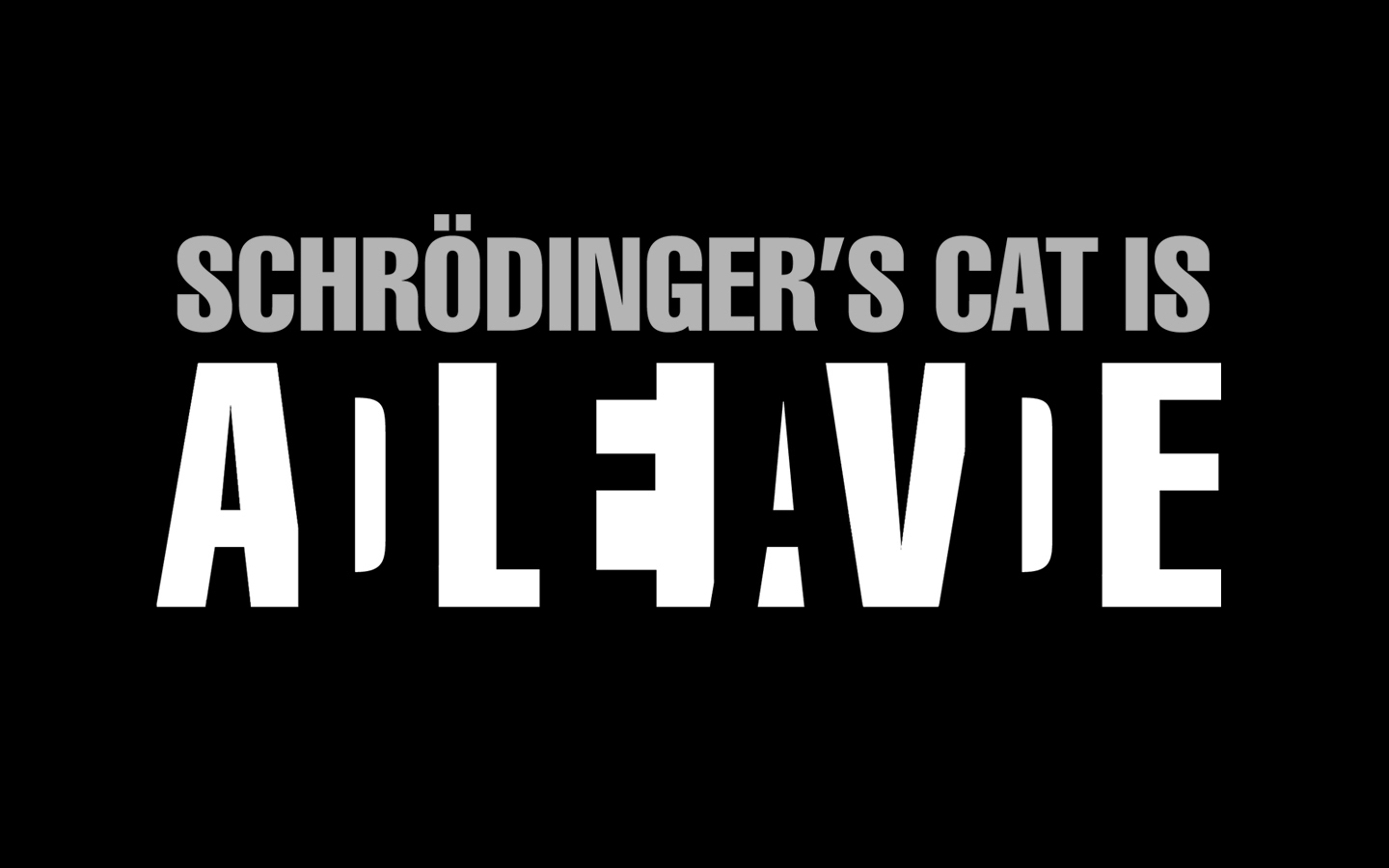Time for the much anticipated sequel to The Double Slit Paradox post! Here is the link to it if you haven't read it: http://standinginfrontoftheuniverse.blogspot.com/2011/06/double-slit-paradox.html.
So as you can guess the Schrodinger's Cat thought experimented by Erwin Schrodinger. At first he was trying to show how preposterous certain interpretations of the Uncertainty Principle to be used on more macroscopic scenarios. The Uncertainty Principle was created by Werner Heisenberg in 1927. He came up with this when he thought of a theoretical measuring device that could give scientists the precise velocity and position of a subatomic particle, e.g. an electron. This device shoots a single photon at an electron. The more precise of a location we want the smaller wavelength of the photon needs to be. However the shorter the frequency the more energy the photon has causing the unknown bounce of the photon off of the electron would have a larger effect (since we don't know where the electron exactly is we don't know where the photon is going to hit the electron so we won't know how electron is going to bounce off when the two collide). So the more we know the electron's position the less we are sure about its velocity and the more we know about its velocity the more uncertain we are about its position. So we have an inverse ratio between the electrons position and velocity. Now this isn't just faults in this hypothetical device. As it turns out its part of nature, for some reason, for us to be completely certain about multiple states of a particle, not with just position and velocity but other quantum states as well.
 |
| The wave functions of the some of the orbits an electron of a hydrogen atom. The whiter it is the more likely an electron will be there when observed. |
Somehow this led some physicists to the idea that when not observed particles expand to a wave function. This function gives us the probability of a particles state e.g. position. When the particle is observed the wave function will "collapse" to a random point in the wave function. The function of a particle will tell us the likely hood the particle will be there when it collapses. So now when physicists thought only photons had a wave/particle duality it turns out every particle can be either a particle or a wave. This electrons, protons, atoms, molecules and even.... you! *gasp*
 |
| That cat is asleep not dead! But I guess people don't like pics of dead cats |
So when this idea came out Schrodinger found this a little odd. This wave function meant that an unobserved particle could hold two states and be in two, or more, places at once. In a way to show how preposterous this could mean, Schrodinger came up with a little thought experiment. He got a completely sound proof and opaque box. In this box he put a cat and a quite devilish little device. This device has an unstable atom and a can detect when it decays. When it does so it unleashes a poison gas easily able to kill a small mammal such as a cat, especially when there is no circulation. When the cat and this device is placed in the box and sealed off there is no way to detect what is going on in the box. The decay of atoms and subatomic particles is governed by the Uncertainty Principle and is completely random when it does decay. However the rate at which this type of theoretical atom decays is known and after an hour there is a fifty/fifty chance that the atom decayed and didn't decay.
So according to the current idea of quantum physics the atom decayed and is still intact simultaneously. This means that this device activated and did not activate and that the defenseless cat is still alive AND dead at the same time. However once someone opens the box than one of the two states is chosen and we would either see a non-conflicting alive OR dead cat. No one knows why Schrodinger picked a sort of morbid thought experiment (because no physicists wants to needlessly kill cats, maybe the device can feed the cat so the cat would be a bit peckish or well fed simultaneously instead of dead or alive), but I guess he just wanted to show how weird this new theory could be.
However instead of debunking this new idea this thought experiment was taken honestly and many physicists think that the cat would indeed be alive and dead at the same time. Some people I think went a little crazy with this idea of observation itself being able to change the world around us. Some people thinks that consciousness, which is what makes us able to "observe" the world, is a fundamental part of the universe, maybe as some fundamental particle which is necessary for life or evidence as a universal consciousness that we are just part of which religions have called God.
One guy I saw on "Through the wormhole" (and yes in hindsight I realized that's very similar to my subtitle thing and I did make mine later, but whatever I like mine and I'm sticking to it) actually saw this as a evidence that we are in some simulation or game since in video games it doesn't render anything the player isn't looking at or doesn't update objects that are decently far from an the player to increase the speed of the game. However there is a huge difference between rendering objects to a screen for a human to understand and the how objects need to be perceived to objects in the simulation it self. In video games points of the model a translated from the position on the model in respect to the objects position in the world, then translated in relative to the camera's position in the world, then projected to a 2d plane which is then rendered onto your screen (there's a few more steps from camera to the screen but there more technical and unnecessary for me to tell you, but that's right I'm learning stuff in video game school XD). This is required for objects to be seen and takes up allot of processing time which is why we don't do that for objects behind you or out of your field of view in a game or simulation. In real life, photons bounce off of objects and certain frequencies are absorbed, the rest go into your eye and hit certain light sensitive cells depending on their relative position to the eye. The entire frequency of white light, usually sunlight, minus the color absorbed by the object gives the incoming light the opposite color which we observe. This happens all the time in a light filled environment whether someone is looking at an object or not. For more reasons why I don't think this world is not a simulation observe this post: http://standinginfrontoftheuniverse.blogspot.com/2011/05/are-we-in-matrix.html
I, being a skeptic atheist, don't believe in anything special about us and do not think there is some sort of ethereal or physical "thing" that is consciousness. As I've said before nothing special happened when three to four billion years ago when life originated. The universe didn't go "These bags of chemicals shall be able to observe and collapse wave functions when these other organic chemicals have no such power!" However I do believe that particles can exist as a wave and have all the implications that come with it, especially since experiments, such as the Double Slit Experiment, prove it. I just think that the definition of "Observation" is misconstrued by some people. When I first heard about the Double Slit Experiment I was like "Whoa! If I open and close my eyes it changes how electrons behave!?" But then reading it up some more I realized that by observing the electrons it something more like Heisenberg's theoretical measuring device. They hit the passing electrons with photons to see which slit it went through (I'm assuming you've read the post I linked at the top so read that first plox). And it was this bombardment that affected the particle and wave like patterns. So looking at something start up doesn't really affect the actions of the observed object since photons are constantly hitting you any ways. However if it's pitch dark, using a flash light to look at the world around you will affect it, not because you're looking at it but because you're hitting it with a flash light, or the photons from the flashlight rather.
 |
| Picture related, but also pretty trippy. |
So now looking at the Schrodinger's Cat experiment with this mentality the answer, to me at least, but what do I know, is that the act of the device that is measuring the unstable atom causes the atom to collapse to the a single decayed/not decayed state. This means that no matter how much the box is sealed off it is still being observed by the device it self not some scientist. So the cat would remain in one state at all time, box being opened or closed regardless. Also I would like to think that the cat would be able to look at itself and decide if it's dead or not, but I guess that brings up other things.
Once again I'm a 20 year old in a gaming school and not taking any quantum physics and am mostly self taught so I could be completely wrong and it would be awesome if some Ph.D in physics came up and told me some awesomeness and correct any mistakes or misinterpretations I made. However I stand in my "This world is not a computer simulation" claim. And of course having a Ph.D or anything is not a prerequisite to leaving comments on my blog (well I guess a computer and hands are but that's more of a physical than a rules thing), so fill free to comment cause, you know, it'll be cool 'n' junk.

No comments:
Post a Comment